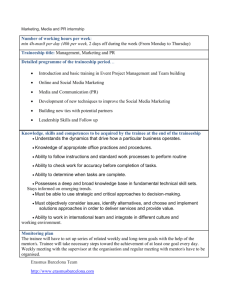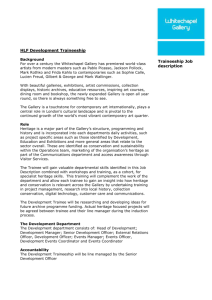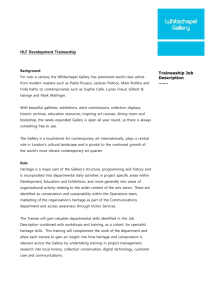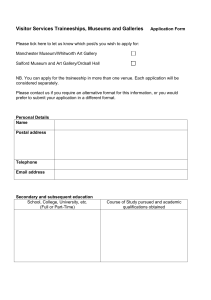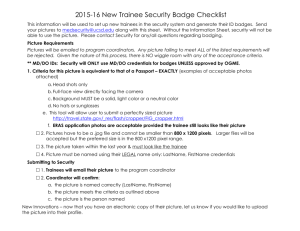Do you really understand the job on offer?
advertisement
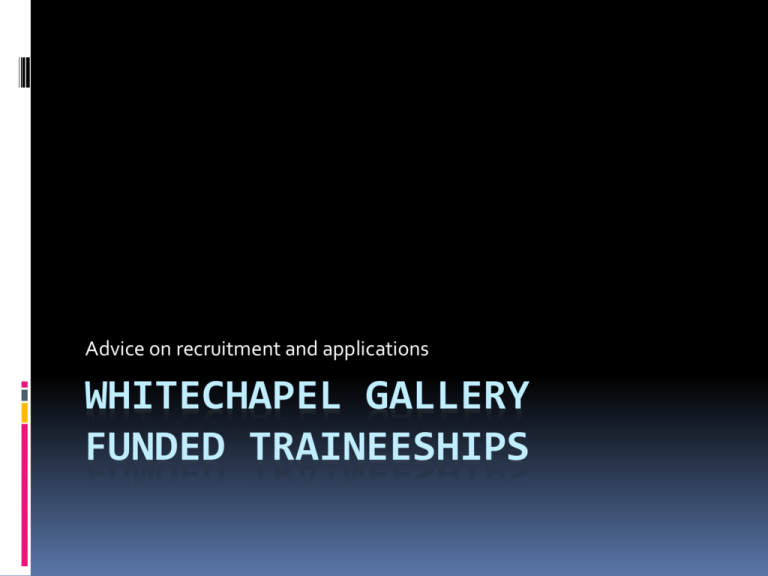
Advice on recruitment and applications WHITECHAPEL GALLERY FUNDED TRAINEESHIPS This programme is supported by the National Lottery through the Heritage Lottery Fund Liz Lydiate Who am I and why am I here today? How selection procedures work, and making them work for you formal application procedures why do we need to have this kind of procedure Equal Opportunities practice difficulties that can arise for the applicant all the stuff we are doing in this session is transferable and will help you with other applications the assumption that catches many people out....... What’s the offer? Located in the LB of Tower Hamlets, the Whitechapel Gallery will run a 2 year project offering training and work placements to 12 local young people using a dedicated grant. Fixed term contract for 12 months, starting April 2011 What does this mean? Are you willing/able to commit for a whole year? Do you qualify as local? Trainees will learn a range of accredited cultural heritage skills within the gallery itself including conservation and research skills, digital technology training and community engagement. Are you genuinely interested in some/all of these things? What’s the offer? The Gallery which first opened its doors in 1901 presents a wealth of modern and contemporary art giving the trainees excellent hands-on experience in the museums and arts sector. Check that you really understand all the terms that are being used. Use the Internet to find out things you don’t know or aren’t sure about What’s the offer? The Gallery is therefore looking to recruit 6 full-time paid positions starting in April 2011. are you able to start in April and commit for one year? Trainees will be spread across 6 different departments: Exhibitions Trainee, Education Trainee, Communications Trainee, Development Trainee, Operations Trainee and Visitor Services Trainee. do you understand these terms and which ones are the most attractive to you? Trainees will gain valuable departmental skills, in their chosen department combined with workshops and training, as a cohort, for specialist heritage skills. This training will complement the work of the department and allow each trainee to gain an insight into how heritage and conservation is relevant across the Gallery by undertaking training in project management, research into local history, collection conservation, digital technology, customer care and communications. do you understand what is meant by heritage and heritage skills? Salary: £13,000 per annum, for each traineeship (salary includes annual national insurance and tax contributions) Help with making the application: 1. always check carefully what’s on offer and what’s wanted (we’ve already made a start on this) 2. usually there will be a job description and a person specification 3. if there isn’t there should be details in the advertisement or on the website, and possibly a name of someone to ask for further information 4. secret weapon – MD’s PA What is a job description? a formal part of the application procedure for most jobs, and a great aid to clarity describes WHAT the post holder will be required to do will give some information about HOW they will work might explain WHO they will work with and WHERE they will be based the information in the job description will form part of the basis for any future contract of employment it also provides much guidance for the applicant, as we will see...... Analysing the person specification competencies ‘essential’ and ‘desirable’ qualities evidence of achievement Deciding whether to give it a go a good application takes time (at least a whole day’s preparation) being turned down is depressing and upsetting increase your chances of getting at least as far as the interview by doing a realistic assessment of your chances how??? Making out your case: 1. how to fill out the application form Personal information avoid using silly e-mail addresses that give too much information e.g. bimbobadgirl@hotmail.com don’t give telephone numbers where there is no-one to answer and no voicemail check your voicemail for inappropriate messages as well, and try to keep toddler relatives away from answering the phone Making out your case: 1. how to fill out the application form Employment information most recent first – why? include both paid and voluntary work ALL work done is useful – why? give name, address and business of employer; dates of employment; salary; brief description of nature of work and responsibilities include evidence of achievements can go onto another sheet of paper if necessary be consistent in your editing Making out your case: 1. how to fill out the application form Education, training and professional qualifications include all school/college/university attendance, giving name of institution, dates attended, qualifications achieved and year obtained include all vocational training and any qualifications, giving name of institution, dates attended, qualifications achieved and year obtained make sure that you have the relevant certificates available; they may be required later on Making out your case: 1. how to fill out the application form Computer and typing skills include details all software packages that you know + indicate level of proficiency can you touch type? what speed? do you have office experience? Making out your case: 1. how to fill out the application form Referees include names and contact details of two referees, including the most recent employer, if you have one referees must be people who know you in a work or educational capacity, and who have been in contact with you recently – they have to give an opinion on your suitability for the post family members and/or relatives are not acceptable; nor is someone who knew you as a child but is not up-to-date with you now ask your referee before putting his/her name down – and it’s a good idea to send them details of the post that you are applying for cherish your referees, you’re going to need them for along time; remember to thank them and give them feedback on your progress Making out your case: 2. using the personal statement This is the most important part of the application 1. it asks you to explain WHY you think you are suitable for the traineeship and the reasons for your application 2. it asks you to explain HOW your experience, qualifications, personal qualities and interests meet the requirements of the Whitechapel Gallery Traineeship Programme 3. it asks for details of any experience that you have had with people from culturally diverse backgrounds Making out your case: 2. using the personal statement for 1. and 2. go through the job description and person specification with a highlighter and identify the key requirements then work through your cv and your memory to find evidence that shows you can meet these requirements include this concisely in your statement, probably following the same sequence as in the application documents, to make the evaluator’s job easy don’t make the false assumption that the evaluator will trawl through the rest of the form to find out whether you meet the post requirements - (many people do!) make it as easy as possible for the evaluator to see what and understand what you already know – communication is all Making out your case: 2. using the personal statement remember it’s a personal statement – it can and should show your personality and your passion allow yourself to be a bit different and unconventional if you want to avoid using ‘I think’ and ‘I feel’ – much better to show what you know and what you have actually achieved think about how commercial marketeers use the concept of unique selling proposition (USP) – can you make and communicate a USP for yourself ? also think abut the concept of the ‘elevator pitch’ – if you found yourself in a lift with (say) Richard Branson or Alan Sugar, what might you say to get them interested in you in the short time available? Making out your case: 3. understanding employability skills When preparing applications remember the key things about employability: Do you really understand the job on offer? Could you do it? Do you really want to do this job or are you wrongly seeing it as a quick route to something else? Would you fit into the organisation? Are you friendly, willing, cheerful, co-operative and hard-working? Can you take initiative? Do you have sound judgement? Are you a problem maker or a problem solver? Where is the evidence to support all this? Your application should provide this, based on awareness of employability issues The Equal Opportunities form the other thing you will need to complete is the Equal Opportunities Form use of this indicates that the recruiting employer subscribes to an agreed national code of practice when recruiting staff in order to give all candidates a fair chance of success in EO recruitment all applicants submit the same type of material for consideration, using the same framework all shortlisted candidates will be asked the same questions at interview so that the panel can accurately compare them one with another EO works against discrimination on grounds of age, gender, sexual orientation, ethnicity, religion, disability Putting it all together even when completing electronic application forms, there is a lot you can do to further improve your chances of success by managing the overall appearance and style of the submission try to give your material a consistent look – choose a nice clear and interesting typeface and actively manage the editing and layout of the pages edit your work carefully in terms of use of capital letters, abbreviations, spelling, and accuracy take active charge of the layout – making the form look well-organised and attractive and the reader’s job more pleasant it is impossible to proof-read your own work – get someone else to read it over for you make your submission have personality and attract attention Remember your application is an advertisement for yourself if you can’t be bothered to do a well-researched, accurate submission when you’re fighting for yourself, it’s pretty clear that you’ll probably do even worse work if hired we live in a busy and crowded world – clear, relevant and fit-for- purpose communications stand out and gain attention Sending in the application follow the submission procedure carefully make sure you meet the deadline keep a copy of what you sent After sending in the application some organisations only contact successful (i.e. shortlisted) applicants contact might be by phone, letter or e-mail Whitechapel will contact ALL Traineeship applicants by e-mail make sure you are available and monitoring your comms if you are unsuccessful for a job where thought you had a good case, it can be useful to ask for feedback if you are invited for interview, acknowledge immediately that you can attend and then start preparing.... How to prepare for an interview to prepare for interview do yet more research about the organisation plan your travel decide how to present yourself (feel good, feel comfortable and BE yourself) arrive in good time , bring something to do while you wait try to anticipate questions and prepare answers learn a relaxation exercise to help if you get nervous switch off your phone!!!! Anticipating interview questions Not as difficult as it sounds! Why are you interested in our organisation? Why would you like this opportunity? What are your goals for the future? What would you like to have achieved in three years’ time? Tell us about something that has given you a sense of achievement What experience do you have of working in teams? Can you tell us about any experience you have had of working with people from different cultures? What are your strengths? What are the three main reasons why you should get this traineeship? Is there anything you would like to ask us? How to present yourself in an interview go into the room, sit down and then look directly at each panel member as they introduce themselves to you – smile! sit up straight but also feel comfortable; your position should show that you are concentrating and fully engaged try to maintain eye contact with each person as they speak to you if possible, include all panel members in your answers by moving your head speak clearly and at the right level for the room give clear, concise answers – don’t ‘rabbit on’ if you get stuck or overcome with nerves, just say so – the panel will understand try to enjoy it at the end, thank the panel for seeing you and say goodbye – don’t ask anything else at this point as they will be working to a strict schedule After the interview you will usually be informed of the outcome by phone, post or e-mail in some jobs it is then possible to carry out some further negotiation about the exact nature of the deal (especially at more senior levels) thank you for your attention do you have any questions?
